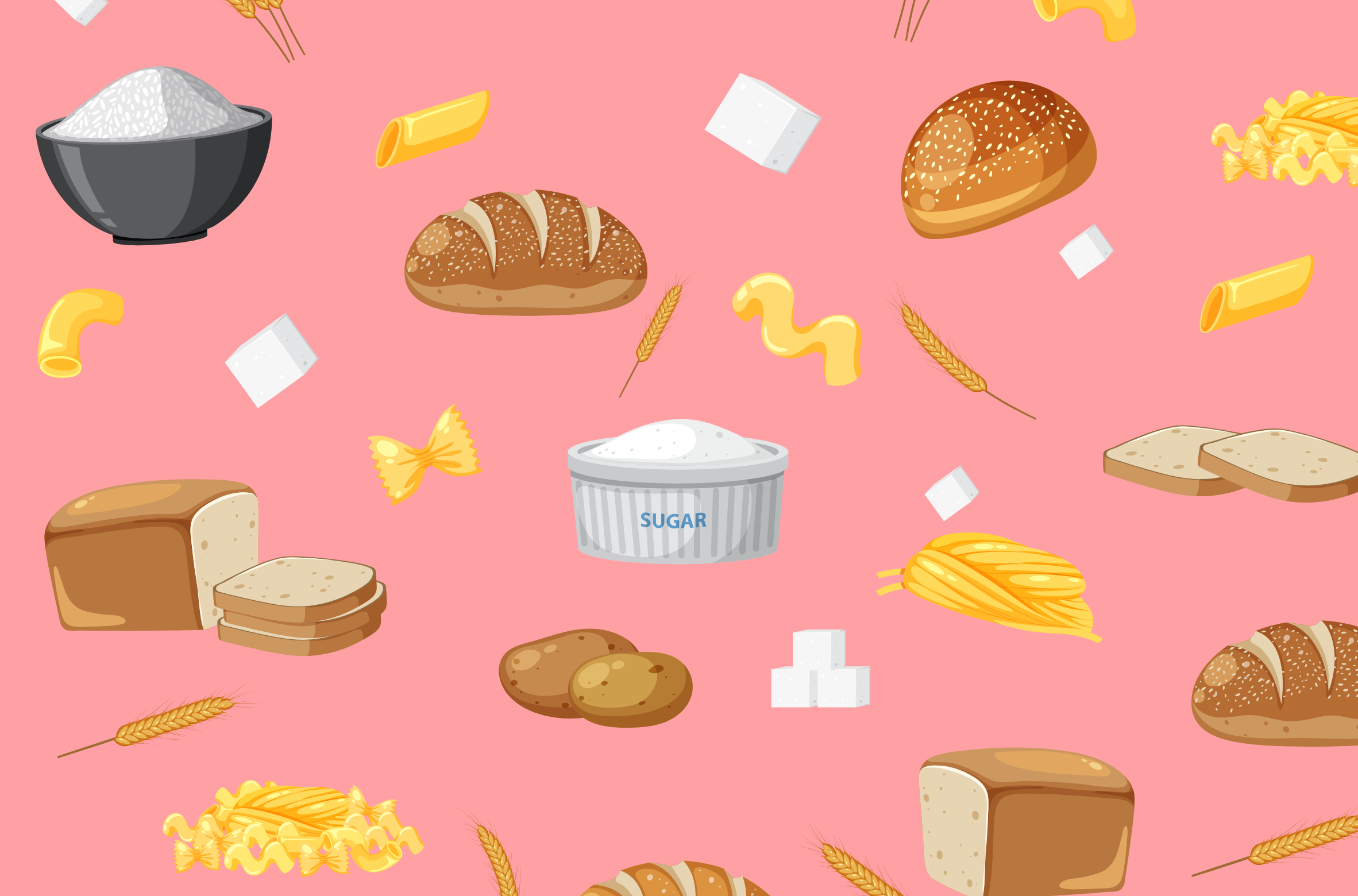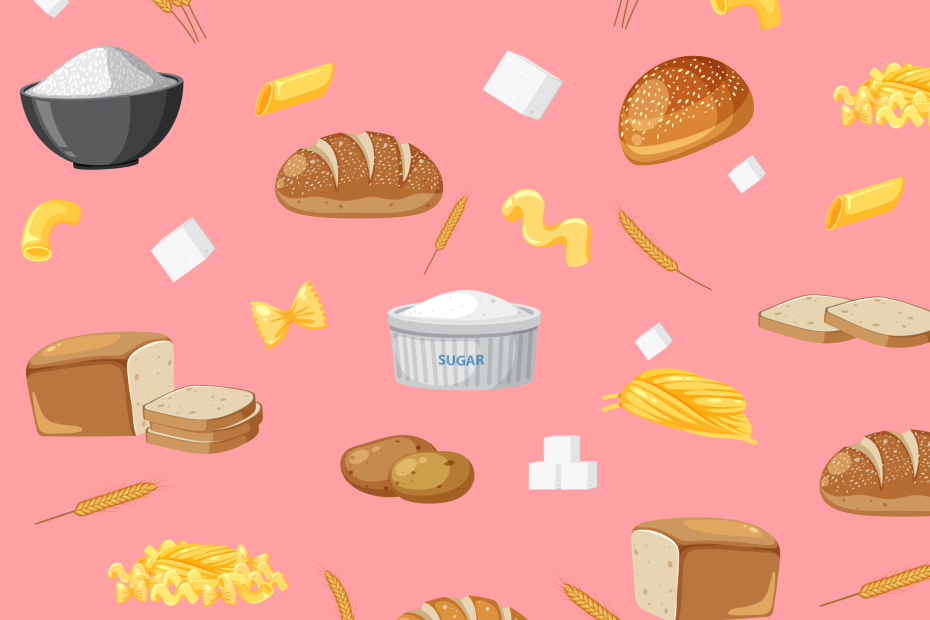Carbohydrates
- Carbohydrates, or carbs, are composed of starch, fiber, and sugar, and categorized as fruit, vegetables or whole grains.
- Starch and sugars contribute 4 calories per gram, while fiber contributes 0 calories per gram.
- Whole grains contain all the fiber, starch, and micronutrients in a grain plant, whereas refined grains only contain the starch.
- Adults should consume a maximum of 25-50 grams of added sugar per day.
- Carbohydrates, or carbs, are found widely in our diet in a variety of forms and serve as our primary fuel source. Most foods containing carbohydrates can be categorized as fruits, vegetables, or whole grains, such as bananas, tomatoes, and rice. Fruits, vegetables, and whole grains appear pretty different yet they are all carbs. The soft, fluffy texture of bread versus the crunchy, fibrous texture of celery is due, in part, to differences in carb composition. The components that make up carbs are starch, fiber, and sugar, and variations in these components can greatly affect the taste, texture, appearance, and smell of foods.
- Typically, 45-65% of a person’s calories will come from carbs, and each gram of carbs contains 4 calories. Calories are the units we use to measure the amount of energy a food contains, so more calories means more energy. A typical diet of 2,000 calories per day allots about 900 – 1300 calories from carbohydrates, with the remaining calories assigned to protein and fat. In order to perform activities, like walking, breathing, digesting our food, and exercise, we need calories as fuel, and we need to eat the same amount of calories as we use throughout the day in order to maintain our weight. Our bodies prefer carbohydrates as our primary source of energy.
Types of Carbs
There are 3 main categories of carbs: starch, fiber, and sugar. Both starches and sugars contribute 4 calories per gram, however fiber, which is the structural component of plants, like the skin on an apple, does not contribute any calories. Yes, you read that right.
On the other hand, starch and sugar are very similar because sugars are the building blocks used to make starches. Simply put, sugar is a chain link and starch is the chain. During digestion of starch, our body breaks down the chain and we use the chain links, or sugar, to make energy. Fiber is similar to starch in that it is a “chain” composed of smaller “chain links”, but our bodies cannot break down the chain. Therefore, we do not derive any energy, or calories, from fiber. Some bacteria in our gut are able to break down fiber through a process called fermentation. As a result, short chain fatty acids (SCFAs) are produced. SCFAs are the main source of energy for cells in our gut, and their production seems to not only affect gut health but may influence communication between the gut and brain.
Many foods contain a combination of starch, fiber, and sugar, and some foods only contain one of the three components. Nearly all carbohydrates fall within the category of fruits, vegetables, or whole grains. Typically, fruits contain sugar and fiber, and vegetables and whole grains contain fiber and starch.
Whole vs. Refined Grains
We are usually recommended to eat whole grains over refined grains, but what is the difference between them? When grain-crops grow, such as wheat or corn, the part of the plant that is taken to be processed for our consumption is called the grain. A grain is teardrop shaped and has 3 main parts (click here for a diagram). The outer shell of the grain is called the bran and contains a lot of fiber. The bran protects the inside layers from hazards in the environment. You may be familiar with bran breakfast cereals, which contain this part of the grain. Within the bran is an area called the endosperm, which is mostly starch and serves as the primary fuel source for the grain plant – even plants prefer carbohydrates for fuel! Further nestled within the endosperm is the germ. The germ is the grain’s reserve of B vitamins, minerals, and some protein and fats.
A whole grain, like whole grain bread or pasta, contains all 3 components of a grain: bran, endosperm, and germ. A refined grain is processed to remove the bran and germ, leaving the starchy, white endosperm, like in white bread. This process leaves a more shelf-stable product with a finer texture that people have grown to love. Vitamins and minerals found in the germ are usually added back to refined grains in a process called enrichment. However, a lack of fiber persists which can lead to steep blood sugar spikes. When picking foods for a healthy lifestyle, you should choose whole grains. Here are some reasons why.
- Feel fuller longer. Whole grains contain fiber, and as stated earlier, we cannot break down and digest fiber. Fiber is bulky and takes up space in our gut, leading to the perception that we are full, which persists long after we eat.
- More micronutrients. Although refined grains usually have some vitamins and minerals added back after the bran and germ are removed, whole grains offer a dense source of B vitamins, vitamin E, magnesium, potassium, phosphorus, iron, and zinc.
- Fiber prevents a blood sugar spike. When we eat foods with starch and sugar, they are released into our body as sugar, which can lead to a blood sugar spike. Fiber physically gets in the way of starch and sugar during digestion, and thus helps maintain a steady blood sugar rise instead of a steep spike.
Sugar, Sugar, Sugar
How much sugar should I eat? Is all sugar bad? Does honey count as sugar? You may have found yourself searching the internet for answers to these questions, and you probably ended up more confused than you did at the start. Here are some brief explanations to help.
- Added sugar. Added sugar is defined as any sugar or sweetener that has been added to a food. This can include granulated sugar, brown sugar, honey, sugars from syrups (e.g. maple syrup, high fructose corn syrup, flavor syrups added to beverages), and concentrated fruit or vegetable juices. Added sugars have their own section on a nutrition facts label.
- Natural sugar. Natural sugar is sugar that is naturally found in a food. For example, this includes the sugar found in fruit or milk.
- How much sugar? Adults should aim for no more than 5-10% of their calories from added For a 2,000 calorie diet, that is 100 – 200 calories or 25 – 50 grams of sugar – a single 12 ounce can of Coke has 39 grams of added sugar. There are no recommendations around the intake of natural sugars, so eat up all the fruit!
- Sneaky sources of sugar. Soda, desserts like cookies and cake, and candy are known for containing sugar, but there are a lot of foods that you would never expect to have added Some of these foods include:
- Condiments like ketchup and barbecue sauce
- Breakfast cereals
- Coffee and tea
- Sports drinks
- Peanut butter
- Salad dressings
Take Home Message
Carbs are complex. They are composed of multiple components (starch, fiber, and sugar) and the amount of each component within a food will affect the food’s taste, texture, appearance, and smell. Contributing 4 calories per gram, except for fiber which contributes 0 calories per gram, carbs tend to supply most of our energy each day. When picking carbs to consume, we should avoid added sugars and pick whole grains over refined grains because of their superior fiber content and dense array of micronutrients. In general, we should prioritize fiber in our diet because it can help us feel fuller longer and supports a healthy gut. Fruits, vegetables, and whole grains are all sources of carbohydrates, and they all contain fiber.
Test Your Knowledge
True or False: We should aim to consume no more than 5-10% of our calories or 25-50 grams of natural or added sugar each day.
Correct Answer: False
Explained: We should aim to consume no more than 5-10% of our calories or 25-50 grams of added sugar only each day. There is currently no recommendation or limit on the amount of natural sugar we should consume each day.
References
- Allai FM, Azad Z, Gul K, Dar BN. Wholegrains: a review on the amino acid profile, mineral content, physicochemical, bioactive composition and health benefits. Int J Food Sci Technol. 2022;57(4):1849-1865. doi:10.1111/ijfs.15071
- Silva YP, Bernardi A, Frozza RL. The Role of Short-Chain Fatty Acids From Gut Microbiota in Gut-Brain Communication. Front Endocrinol. 2020;11. Accessed January 29, 2023. https://www.frontiersin.org/articles/10.3389/fendo.2020.00025
- Yang Q, Zhang Z, Gregg EW, Flanders WD, Merritt R, Hu FB. Added Sugar Intake and Cardiovascular Diseases Mortality Among US Adults. JAMA Intern Med. 2014;174(4):516-524. doi:10.1001/jamainternmed.2013.13563
 share
share



